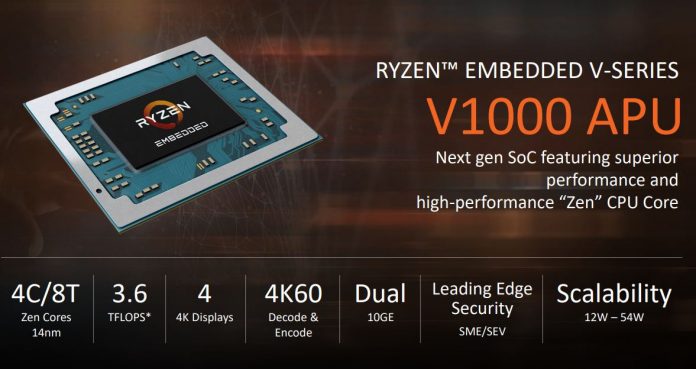On the same day that AMD Ryzen APUs were launched with Zen CPUs and Vega graphics, we were in London, England, attending another product launch for AMD: the AMD Ryzen Embedded V1000 series. The AMD Ryzen Embedded V1000 series essentially combines two of AMD’s strongest IP blocks, the Zen x86 core architecture with Vega GPU capabilities into a BGA package. More like notebook packaging than desktop packaging, these BGA parts reduce footprint and are generally the domain of the embedded market.
AMD Ryzen Embedded V1000 Series Overview
Most industry observers that saw the Zen x86 CPU cores being married with Vega generation GPU graphics, will have seen an embedded part in the making. AMD now has strong x86 and GPU cores and the ability to integrated them which makes the technology compelling in principle.
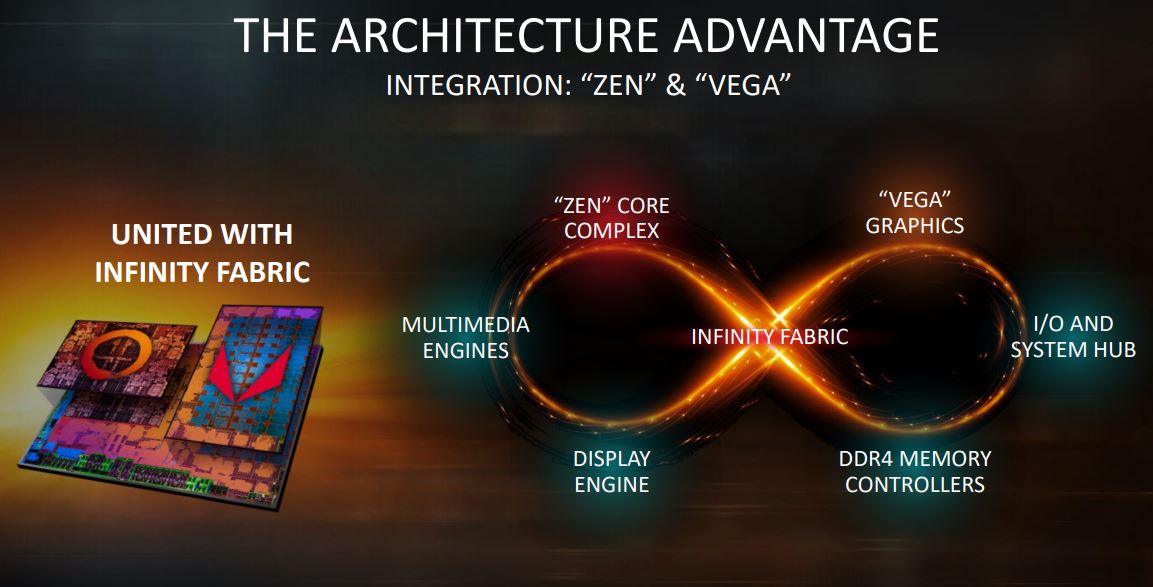
In terms of the highlights of the AMD Embedded V-Series V1000 APU, the 14nm chip can have up to 4 cores and 8 threads, or half of what the first generation Ryzen can have. Instead of using extra transistor space for CPU cores, the additional footprint is dedicated to the embedded GPU. Unlike the Intel Xeon E3-1200 series or embedded Core lines, this is higher-end GPU compute. Intel itself acknowledges the need for higher-end GPUs as we have discussed in our Intel Xeon E3-1500 V5 system review which included Iris Pro graphics.
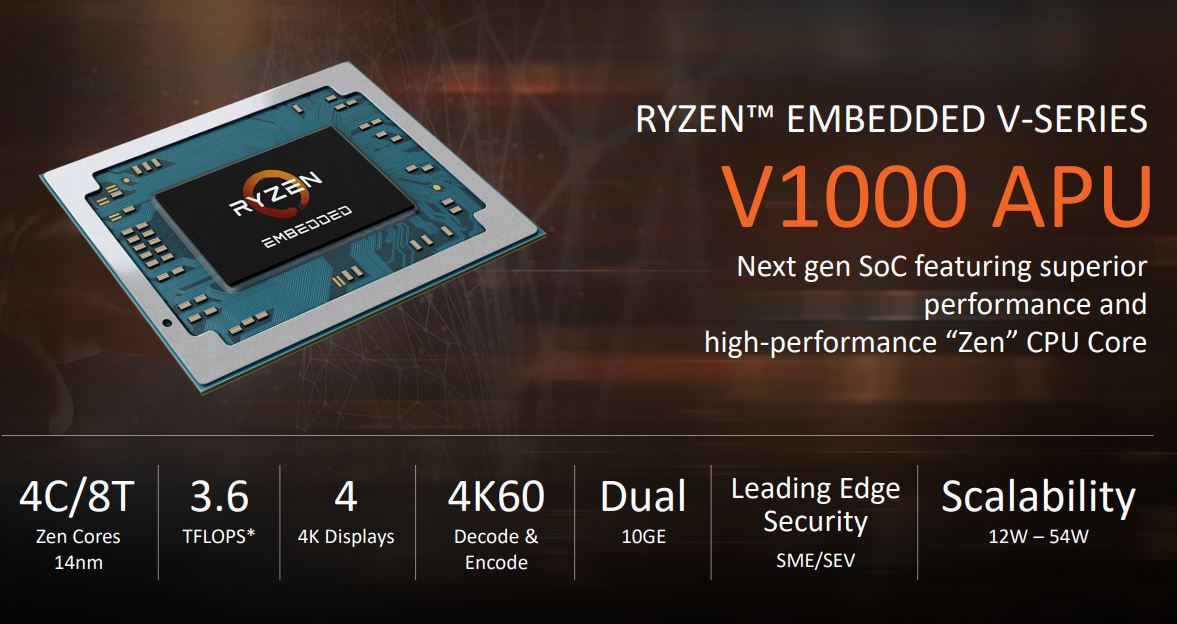
Here is AMD’s Ryzen Embedded V1000 family chart. One can see that the TDP ranges are 12-54W. These TDP ranges are represented as ranges as an OEM can specify the envelope they want to work in. Instead of creating higher cost/ lower power SKU differentiation, AMD is using fewer parts but allowing a customer to dial in a performance per watt level they feel meets their target market.
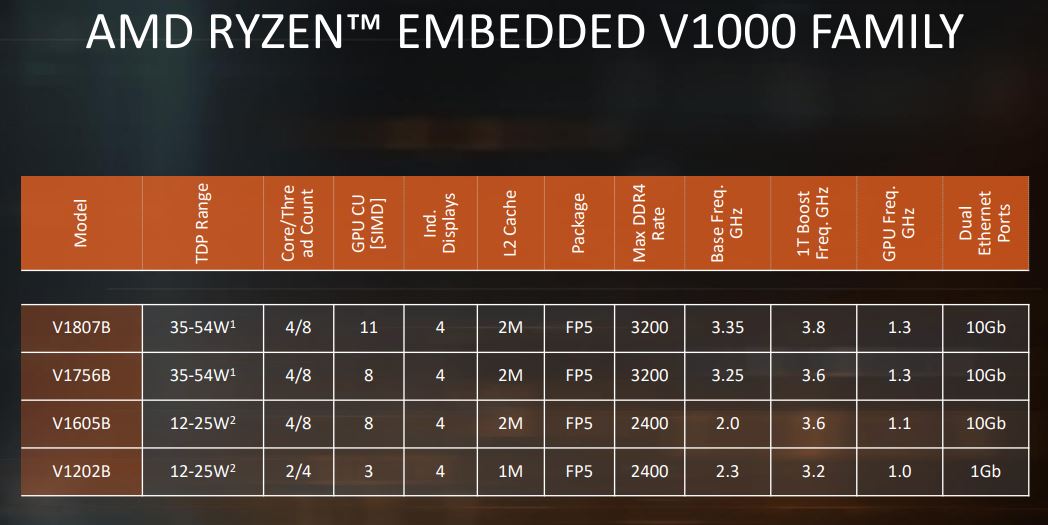
One will also notice that there is a 2 core / 4 thread part, the V1202B. This also has the lowest-end GPU compute units and does not have 10GbE.
A key differentiator is that the quad-core models, from the V1807B to the V1605B, have dual 10GbE. When you compare that to the Intel Xeon E3 line that is a major differentiator. Embedding 10GbE controllers onto a platform adds cost, power consumption, and complexity.
At a similar TDP, AMD claims better or equivalent CPU performance and better performance on the GPU side.
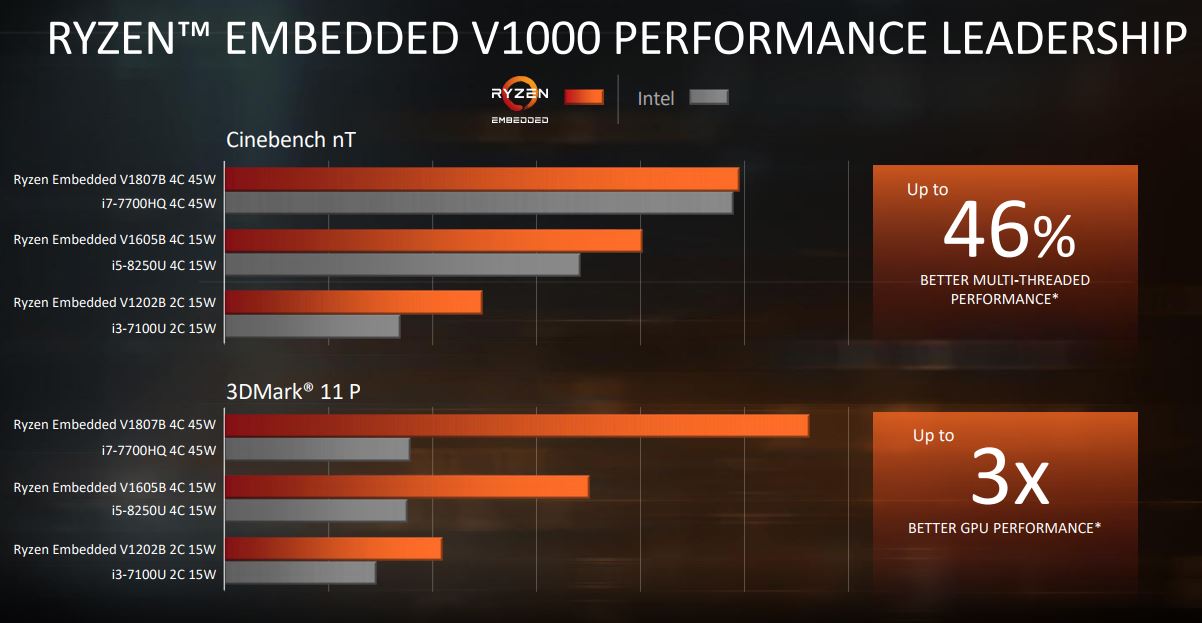
Using Cinebench, which is borderline the best case possible for Zen-based architectures, is not a great point to use for comparison. We do know that on the CPU side, the AMD Zen cores are ball-park competitive on most CPU benchmarks.
On the GPU side, especially excluding the higher-end Intel Xeon E3-1500 embedded products, this is a much clearer picture. Intel iGPUs have been known for fairly basic gaming functionality.
AMD Ryzen Embedded V1000 Launch Landscape
Perhaps the most important part of the launch is the fact that AMD can claim broad compatibility. It can claim native x86 CPU compatibility, something the ARM vendors cannot match. In positioning against Intel, it can claim that its GPU compute units can run the same code as its higher-end GPUs.
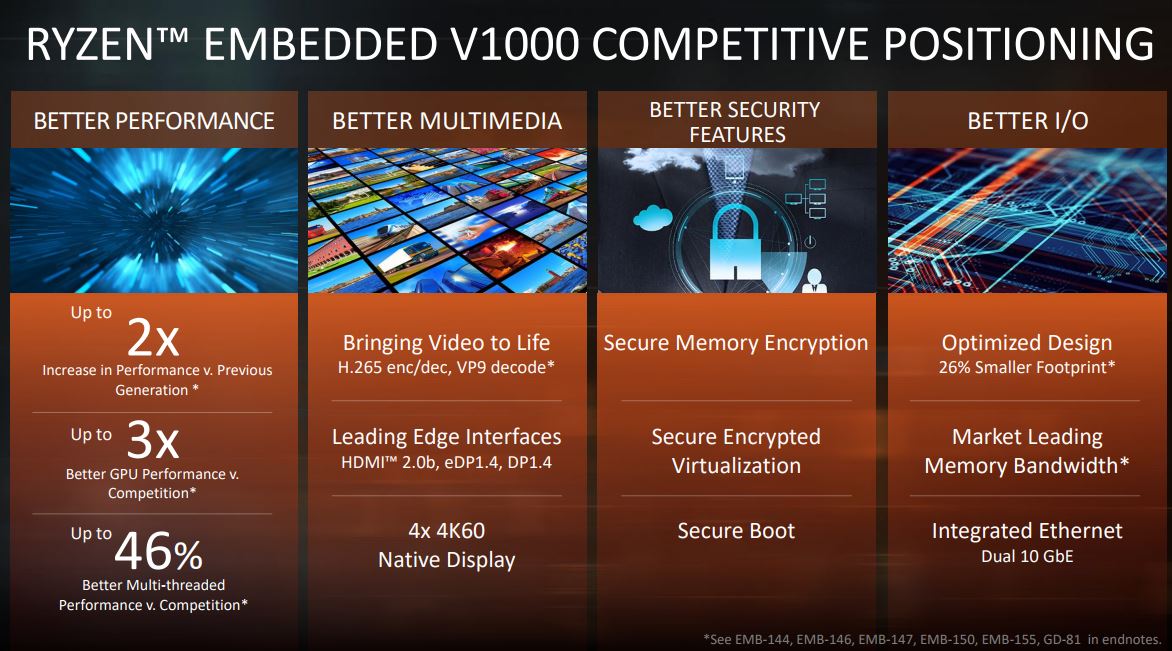
Intel does a good job of getting its drivers into major OSes, but there is still a benefit regarding using the same compute units across platforms. On the other side, this is a similar message to what NVIDIA touts from its data center GPUs to autonomous vehicle platforms and one that Intel does not have a good story on. Essentially AMD can say that your x86 code will run natively on its CPU cores and your Vega code will run on its embedded GPU cores. Neither Intel nor NVIDIA have that unique combination in the embedded market.
Some of the big features the Vega GPU gives include support for 4x 4K60 display outputs. This is important as a major Xeon E3 / embedded Intel Core market is digital signage. We had the opportunity to see displays being run by the V1000 at the event and heard customer testimonials around how transformative this is at a time when the digital signage industry is booming. Likewise, with the H.265 encode/ decode and the VP9 decode, AMD can offload heavy video handling to dedicated silicon which is important for video capture and playback.
AMD also focuses heavily on its secure memory encryption and virtualization technologies. AMD pushed the security features during its EPYC 7000 series launch, but embedded devices have a unique lifecycle. They are often deployed in environments with easier physical access than data center products and so AMD’s security technologies can limit the ability of a malicious actor to gain unencrypted access to a system.
AMD Ryzen Embedded V1000 Series Launch Ecosystem
In terms of the launch ecosystem, AMD has support for some of the major embedded OS vendors. We would have liked to have seen RHEL/ CentOS on this list, but in the digital signage market, these are reasonable options.
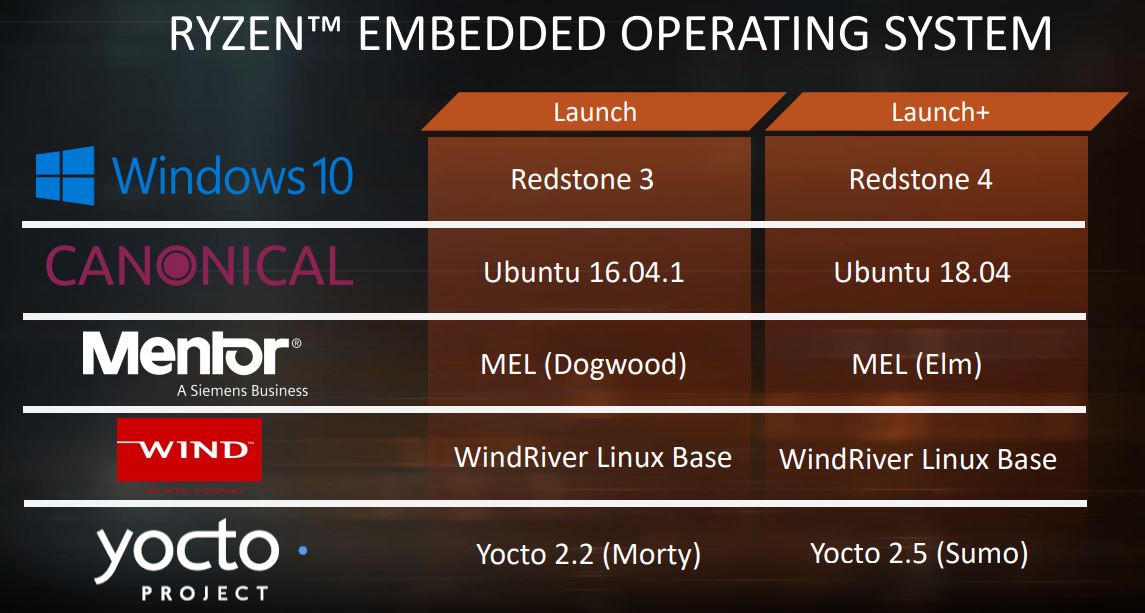
When it came to the partner list, AMD had a slide near the end of their presentation. Here it is:
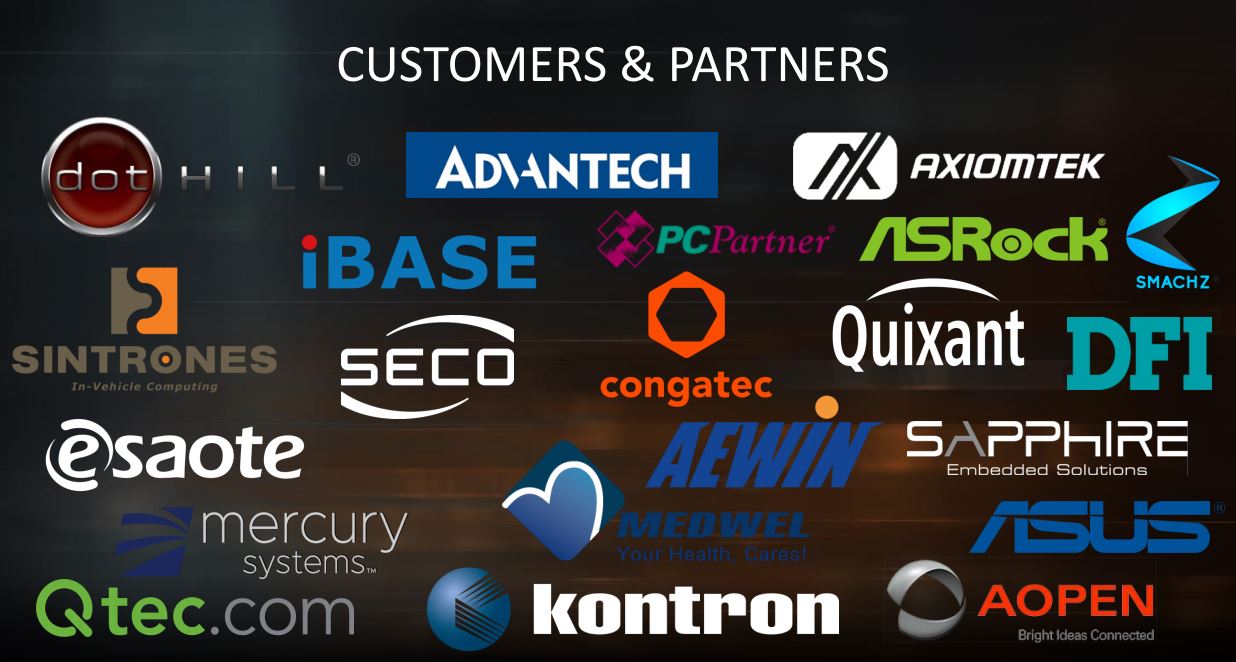
Notable manufacturers, we would have liked to have seen: Dell EMC, Lenovo, Supermicro to start. HPE is not on the list but presented an EPYC 7000 series based HPE ProLiant DL385 Gen10 demo alongside an EPYC 3000 series embedded product.
The embedded market is a bit different than the general server market. Some of the vendors, e.g. Advantech focus primarily on embedded platforms. Here is the Advantec SOM-5871 supporting dual-channel DDR4 (ECC memory support optional) and up to four independent displays in a PCMIG COM.0 R3.0 Type 6 form factor.
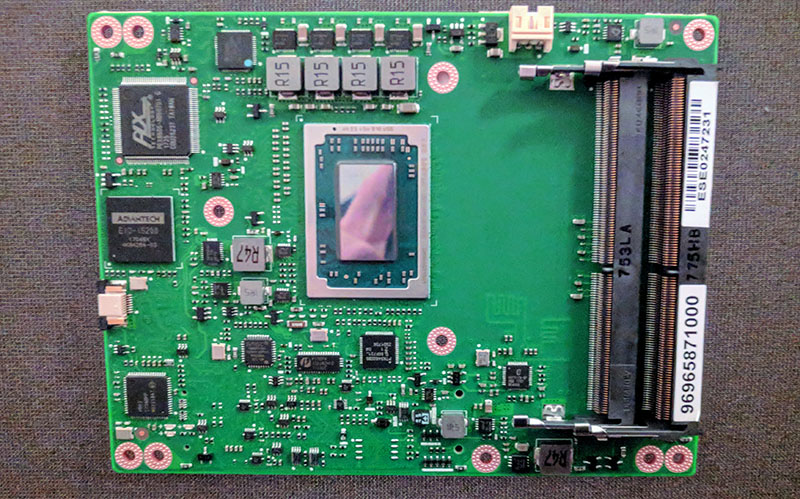
Another AMD partner highligted prominently was Quixant with its line of embedded systems for the gaming segment. These units can be used, for example, to power a Las Vegas casino’s machines or digital signage above games.

Again, given the market that AMD is addressing with this product, it is a reasonable lineup of ecosystem support.
Final Words
This is one of the no-brainer solutions for AMD. The AMD Ryzen Embedded V1000 has strong x86 CPU and GPU IP for the first time in awhile and is able to marry them onto a part. By increasing the compute capacity in smaller form factors, AMD enables embedded solutions providers to address the next set of embedded applications in small form factor systems which is a benefit in space-constrained environments such as integrated display logic, airplanes, and medical devices. Beyond this, AMD has platform-level features Intel does not currently match including dual 10GbE and security features like encrypted memory. For embedded systems providers, there is now a choice in the market where one can keep their x86 code running well and use an option other than Intel.

